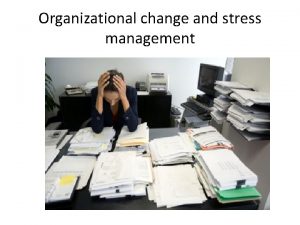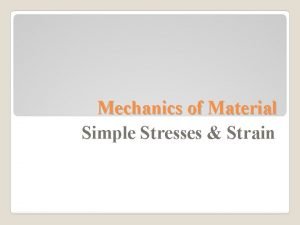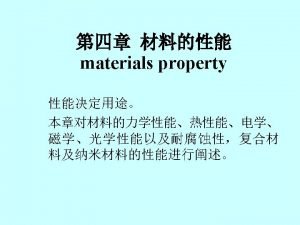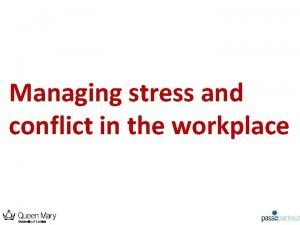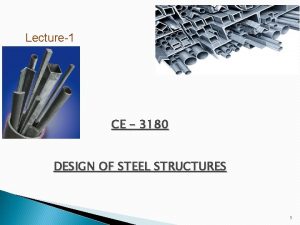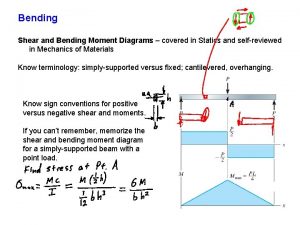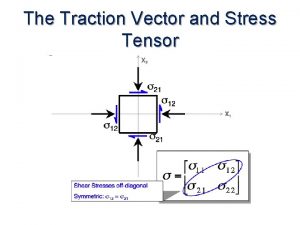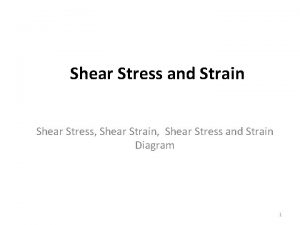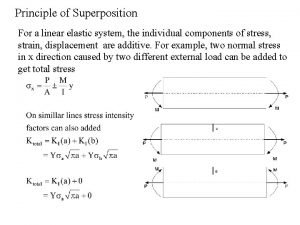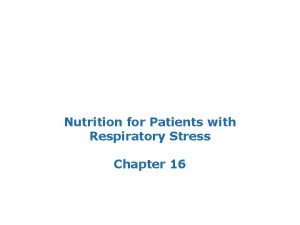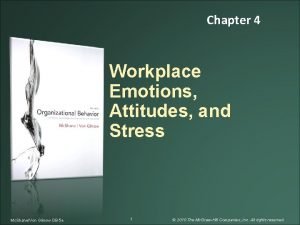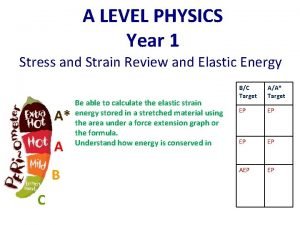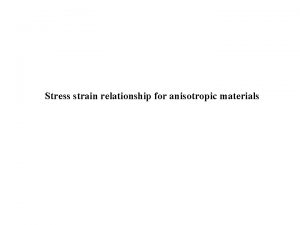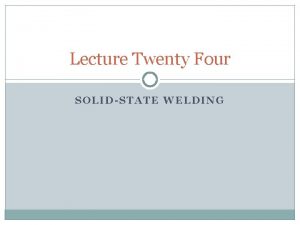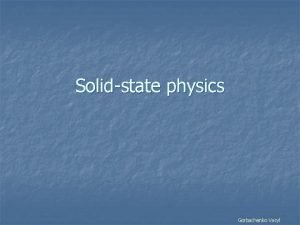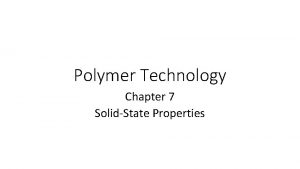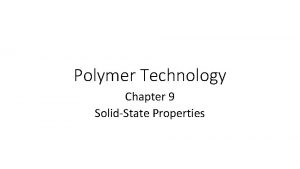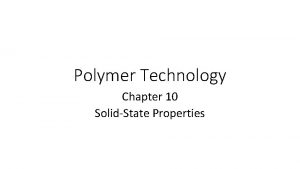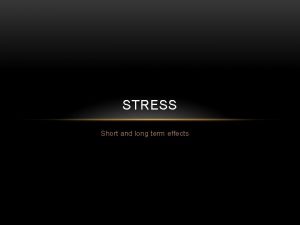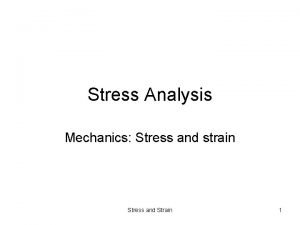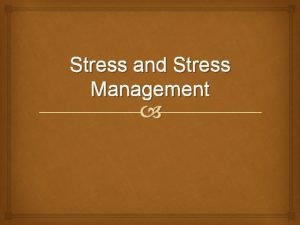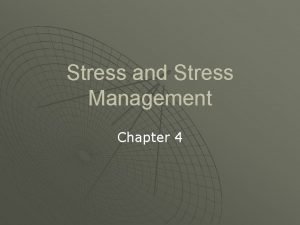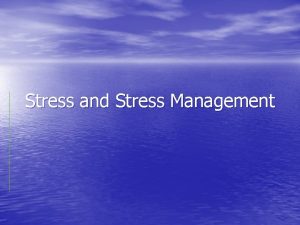Effects of SolidState and PoreFluid Chemistry and Stress









![Typical Response of Fractures (Dissolution) [Polak et al. , GRL, 2003] g 3. Typical Response of Fractures (Dissolution) [Polak et al. , GRL, 2003] g 3.](https://slidetodoc.com/presentation_image_h/a4a445b1ef3f150a6e3164b327b937d5/image-10.jpg)



![Matching Compaction Data [Experimental data from Elias and Hajash, 1992] Matching Compaction Data [Experimental data from Elias and Hajash, 1992]](https://slidetodoc.com/presentation_image_h/a4a445b1ef3f150a6e3164b327b937d5/image-14.jpg)







![Modeling Results - Novaculite K+~x 300 [Yasuhara et al. , JGR, 2004] g Modeling Results - Novaculite K+~x 300 [Yasuhara et al. , JGR, 2004] g](https://slidetodoc.com/presentation_image_h/a4a445b1ef3f150a6e3164b327b937d5/image-22.jpg)





![Observations of Induced Seismicity (Basel) [Goertz-Allmann et al, 2011] g 3. ems. psu. Observations of Induced Seismicity (Basel) [Goertz-Allmann et al, 2011] g 3. ems. psu.](https://slidetodoc.com/presentation_image_h/a4a445b1ef3f150a6e3164b327b937d5/image-28.jpg)


![Seismic –vs- Aseismic Events Duration (s) [secs -> years] Seismic Moment (N. m) [Magnitude] Seismic –vs- Aseismic Events Duration (s) [secs -> years] Seismic Moment (N. m) [Magnitude]](https://slidetodoc.com/presentation_image_h/a4a445b1ef3f150a6e3164b327b937d5/image-31.jpg)





- Slides: 36

Effects of Solid-State and Pore-Fluid Chemistry and Stress on Permeability Evolution Derek Elsworth (Penn State) and Josh Taron (USGS) Basic Observations of Permeability Evolution – EGS and SGRs Key Issues in EGS and SGRs Spectrum of Behaviors EGS to SGR Homogeneous Permeability Flow Modes Diagenesis Permeability Evolution Basin Evolution Stimulation and Production Scaling Relations in Rocks and Proppants Reinforcing Feedbacks Induced Seismicity Mineralogical Transformations – Seismic -vs- Aseismic First- and Second-Order Frictional Effects Key Issues g 3. ems. psu. edu 1 derek. elsworth@psu. edu

Basic Observations of Permeability Evolution Resource • Hydrothermal (US: 104 EJ) • EGS (US: 10 7 EJ; 100 GW in 50 y) Challenges • Prospecting (characterization) • Accessing (drilling) • Creating reservoir • Sustaining reservoir • Environmental issues Observation • Stress-sensitive reservoirs • T H M C all influence via effective stress • Effective stresses influence • Permeability • Reactive surface area • Induced seismicity Understanding T H M C is key: • Size of relative effects of THMC(B) • Timing of effects • Migration within reservoir • Using them to engineer the reservoir g 3. ems. psu. edu Permeability Reactive surface area Induced seismicity 2 derek. elsworth@psu. edu

Key Questions in EGS and SGRs Needs • • • Fluid availability • Native or introduced • H 20/CO 2 working fluids? Fluid transmission • Permeability micro. D to m. D? • Distributed permeability Thermal efficiency • Large heat transfer area • Small conduction length Long-lived • Maintain m. D and HT-area • Chemistry Environment • Induced seismicity • Fugitive fluids Ubiquitous g 3. ems. psu. edu [Ingebritsen and Manning, various, in Manga et al. , 2012] 3 derek. elsworth@psu. edu

Contrasts Between EGS & SGRs EGS (Order of Mag. ) Property ESRs (Order of Mag) Fractured-non-porous General Porous-fractured Porosity, n 0 -> nstim ~10 -30%, ~same <<1%, <1% micro. D -> m. D 106 10 -100 m >>100/1 ? Permeability, k 0 -> kstim Kf/kmatrix Heat transfer length, s *Heatsolid/Heatfluid Chemistry >m. D -> >m. D 106 ->1 1 m -> 1 cm ~10/1 -2/1, same ? V. Strong TM Perm. Feedbacks Less strong Moderate, late time TC Perm. Feedbacks Strong? 4 derek. elsworth@psu. edu g 3. ems. psu. edu

Thermal Drawdown EGS –vs- SGRs Rock Temp (in reservoir) In-Reservoir Water Temperature Distributions: Thermal Output: g 3. ems. psu. edu Water Temp (at outlet) 5 derek. elsworth@psu. edu

Thermal Recovery at Field Scale Parallel Flow Model Spherical Reservoir Model Dimensionless temperature [Gringarten and Witherspoon, Geothermics, 1974] Spacing, s, is small g 3. ems. psu. edu [Elsworth, JGR, 1989] Trock [Note: not linear in log-time] Spacing, s, is large Tinjection Dimensionless time [Elsworth, JVGR, 1990] 6 Dimensionless time derek. elsworth@psu. edu

What Does This Mean? This makes the case that: Permeability needs to be large enough to allow Mdot_sufficient without: 1. Fracturing reservoir during production 2. Large pump costs Beyond that – issues of heterogeneity are imp: 1. No feedbacks (Rick) 2. Reinforcing feedbacks (Kate/Paul/Golder/ Gringarten) Diagenesis contributes to this: 1. Initial basin evolution [k 0, n 0] 2. Reservoir stimulation/development [k, n=f(t)] 3. Reinforcing feedbacks [k, n=f(x, t)] for THMC g 3. ems. psu. edu 7 derek. elsworth@psu. edu

Effects of Solid-State and Pore-Fluid Chemistry and Stress on Permeability Evolution Derek Elsworth (Penn State) and Josh Taron (USGS) Basic Observations of Permeability Evolution – EGS and SGRs Key Issues in EGS and SGRs Spectrum of Behaviors EGS to SGR Homogeneous Permeability Flow Modes Diagenesis Permeability Evolution Basin Evolution Stimulation and Production Scaling Relations in Rocks and Proppants Reinforcing Feedbacks Induced Seismicity Mineralogical Transformations – Seismic -vs- Aseismic First- and Second-Order Frictional Effects Key Issues g 3. ems. psu. edu 8 derek. elsworth@psu. edu

Controls on Reservoir Evolution Many processes of vital importance to EGS/SGR are defined by coupled THMC processes. Thermal sweep/fluid residence time Short circuiting Induced seismicity Prolonged sustainability of fluid transmission Fractures dominate the fluid system transfer Transmission characterized by: History of mineral deposition Chemo-mechanical creep at contacting asperities Mechanical compaction Shear dilation and the reactivation of relic fractures g 3. ems. psu. edu 9 derek. elsworth@psu. edu
![Typical Response of Fractures Dissolution Polak et al GRL 2003 g 3 Typical Response of Fractures (Dissolution) [Polak et al. , GRL, 2003] g 3.](https://slidetodoc.com/presentation_image_h/a4a445b1ef3f150a6e3164b327b937d5/image-10.jpg)
Typical Response of Fractures (Dissolution) [Polak et al. , GRL, 2003] g 3. ems. psu. edu 10 derek. elsworth@psu. edu

Typical Response of Fractures (Precipitation) Experimental arrangement Precipitation Thermal gradient along fracture [Dobson et al. , 2001] g 3. ems. psu. edu 11 derek. elsworth@psu. edu

Dissolution Processes Approaches to Determine dk or db s Db s grain dissolution Time precipitation diffusion grain s s Time Db

Component Model • Interface Dissolution • Interface Diffusion • Pore Precipitation [Yasuhara et al. , JGR, 2003]
![Matching Compaction Data Experimental data from Elias and Hajash 1992 Matching Compaction Data [Experimental data from Elias and Hajash, 1992]](https://slidetodoc.com/presentation_image_h/a4a445b1ef3f150a6e3164b327b937d5/image-14.jpg)
Matching Compaction Data [Experimental data from Elias and Hajash, 1992]

System Evolution at 35 -70 MPa and 150°C Observation 70 MPa and 150°C [Experimental data from Elias and Hajash, 1992] [Yasuhara et al. , JGR, 2003] Extension 35 MPa and 150°C

Timescales of Evolution of Granular Systems at 35 MPa and 75 -150°C 75°C [Yasuhara et al. , JGR, 2003] 150°C

Permeability Evolution in Granular Systems at 35 MPa and 75 -300°C 75°C 150°C 300°C [Yasuhara et al. , JGR, 2003]

Fracture/Proppant Diagenesis g 3. ems. psu. edu 18 derek. elsworth@psu. edu

Do we understand the mechanisms? Various mechanisms – appear complex but include: • Dissolution/precipitation • Solid and aqueous chemical transformations • Fluid/chemical assisted strength loss of proppant and proppant collapse Observation Experiment Characterization Analysis [Dae Sung Lee et al. , 2009]

THMC/HPHT Continuum Models Spatial Permeability Evolution THMC-S – Linked codes Temporal Permeability Evolution g 3. ems. psu. edu 20

Constraint on Fracture Apertures and Fluid Concentrations dc Asperity contacts (a ) Local contact area, Alc (b ) (c ) g 3. ems. psu. edu 21 Increasing fracture closure
![Modeling Results Novaculite Kx 300 Yasuhara et al JGR 2004 g Modeling Results - Novaculite K+~x 300 [Yasuhara et al. , JGR, 2004] g](https://slidetodoc.com/presentation_image_h/a4a445b1ef3f150a6e3164b327b937d5/image-22.jpg)
Modeling Results - Novaculite K+~x 300 [Yasuhara et al. , JGR, 2004] g 3. ems. psu. edu 22

Projected Response of Fracture Define projected behavior for varied temperatures …. and mean stress magnitudes g 3. ems. psu. edu 23 [Yasuhara et al. , JGR, 2004]

Reactive - Hydrodynamic Controls Peclet No. (Pe) Pe < 1 Dispersion dominated – Perturbations damped Pe > 1 Advection dominated – Perturbations enhanced Damkohler No. (Da) Pe. Da No. (Removes <q>) Da << 1 Reaction slow Undersaturated along fracture – Perturbations damped Da larger << 1 – Reaction faster Saturated along fracture – Perturbations enhanced [Sherwood No. ]

Reactive Hydrodynamics: Role of Damkohler Number (Pe. Da) High Pe. Da 15 cm x 10 cm Voxel = 1 mm Aperture: Black (0)White(0. 25 mm) Low Pe. Da Time [Detwiler and Rajaram, WRR, 2007]

Effects of Solid-State and Pore-Fluid Chemistry and Stress on Permeability Evolution Derek Elsworth (Penn State) and Josh Taron (USGS) Basic Observations of Permeability Evolution – EGS and SGRs Key Issues in EGS and SGRs Spectrum of Behaviors EGS to SGR Homogeneous Permeability Flow Modes Diagenesis Permeability Evolution Basin Evolution Stimulation and Production Scaling Relations in Rocks and Proppants Reinforcing Feedbacks Induced Seismicity Mineralogical Transformations – Seismic -vs- Aseismic First- and Second-Order Frictional Effects Key Issues g 3. ems. psu. edu 26 derek. elsworth@psu. edu

Triggered Seismicity – Key Questions THMC Model: Principal trigger - change in (effective) stress regime: Fluid pressure Thermal stress Chemical creep How do these processes contribute to: Rates and event size (frequencymagnitude) Spatial distribution Time history (migration) How can this information be used to: Evaluate seismicity Manage/manipulate seismicity Link seismicity to permeability evolution Reservoir Conditions: g 3. ems. psu. edu 27 derek. elsworth@psu. edu
![Observations of Induced Seismicity Basel GoertzAllmann et al 2011 g 3 ems psu Observations of Induced Seismicity (Basel) [Goertz-Allmann et al, 2011] g 3. ems. psu.](https://slidetodoc.com/presentation_image_h/a4a445b1ef3f150a6e3164b327b937d5/image-28.jpg)
Observations of Induced Seismicity (Basel) [Goertz-Allmann et al, 2011] g 3. ems. psu. edu [Shapiro and Dinske, 2009] 28 derek. elsworth@psu. edu

r-t Plot - Fluid and Thermal Fronts and Induced Seismicity Parameters utilized in simulation k 0 Permeability[m 2] 10 -17 Q: Flow rate Pp Pore Pressure[Mpa] 14. 8 t: Time Pinj Fluid Pressure[Mpa] 17. 8 h: Thickness Porosity Tres Reservoir Temperature[°c] 250 ϕ: b: Aperture Tinj Fluid Temperature[°c] 70 S Fracture Spacing[m] 10 to 500 [Izadi and Elsworth, in review, 2013] g 3. ems. psu. edu 29 derek. elsworth@psu. edu

Fault Reactivation (and Control) Controls on Magnitude and Timing: kfault & kmedium [10 -16 – 10 -12 m 2] Injection temperature d. T [50 C – 250 C] Stress field obliquity [45 -60 degrees] Fault Permeability & Magnitude Timing Injection well [Gan and Elsworth, in review, 2013] g 3. ems. psu. edu 30
![Seismic vs Aseismic Events Duration s secs years Seismic Moment N m Magnitude Seismic –vs- Aseismic Events Duration (s) [secs -> years] Seismic Moment (N. m) [Magnitude]](https://slidetodoc.com/presentation_image_h/a4a445b1ef3f150a6e3164b327b937d5/image-31.jpg)
Seismic –vs- Aseismic Events Duration (s) [secs -> years] Seismic Moment (N. m) [Magnitude] g 3. ems. psu. edu 31 [Peng and Gomberg, Nature Geosc. , 2010] derek. elsworth@psu. edu

Approaches – Rate-State versus Brittle Behavior System Stiffness (Stored Energy) Rate-State Low velocity µ 0 a ln(v/v 0) Brittle High velocity Low velocity Failure Criterion (Trigger) Coefficient of friction -b ln(v/v 0) (a-b)ln(v/v 0) DC Displacement g 3. ems. psu. edu 32 derek. elsworth@psu. edu

Seismic –vs- Aseismic Events Friction Velocity Strengthening (stable slip) Velocity Weakening (unstable slip) Stability (a-b) [Ikari et al. , Geology, 2011] g 3. ems. psu. edu 33 derek. elsworth@psu. edu

Permeability Scale Effects in Hydrology – Space and Time • • • Remote earthquakes trigger dynamic changes in permeability Unusual record transits ~8 y Sharp rise in permeability followed by slow “healing” to background Scales of observations: – – – Field scale Laboratory scale Missing intermediate scale with control [Elkhoury et al. , Nature, 2006] Permeability •

Role of Wear Products Sample Holder Sample Shear-Permeability Evolution Dissolution Products [Faoro et al. , JGR, 2009] g 3. ems. psu. edu 35 derek. elsworth@psu. edu

Key Questions in EGS and SGRs Needs • • Fluid availability • Native or introduced – fluid/geochemical compatibility • H 20/CO 2 working fluids? – arid envts. Fluid transmission • Permeability micro. D to milli. D? – high enough? • Distributed permeability • • Characterizing location and magnitude Defining mechanisms of perm evolution (chem/mech/thermal) Well configurations for sweep efficiency and isolating short-circuits Thermal efficiency • Large heat transfer area – better for SGRs than EGS? • Small conduction length – better for SGRs than EGS? Long-lived • Maintain m. D and HT-area – better understanding diagenetic effects? • Chemistry - complex Environment • Induced seismicity - Event size (max)/timing/processes (THMCB) • Fugitive fluids – Fluid loss on production and environment – seal integrity Ubiquitous g 3. ems. psu. edu 36 derek. elsworth@psu. edu
 True stress vs engineering stress
True stress vs engineering stress Chapter 10 stress responses and stress management
Chapter 10 stress responses and stress management What is the definition of axial stress
What is the definition of axial stress Stress effects
Stress effects Ib organic chemistry functional groups
Ib organic chemistry functional groups Inorganic vs organic chemistry
Inorganic vs organic chemistry Causes and effects of the french and indian war
Causes and effects of the french and indian war Change and stress management
Change and stress management Strain formula
Strain formula Neurotic stress-related and somatoform disorders
Neurotic stress-related and somatoform disorders Simple stress and strain
Simple stress and strain Stress curve and phases
Stress curve and phases Stress and conflict introduction
Stress and conflict introduction Chapter 8 managing stress and anxiety
Chapter 8 managing stress and anxiety Design philosophy of steel structure
Design philosophy of steel structure Chapter 4 managing stress and coping with loss notes
Chapter 4 managing stress and coping with loss notes Organization change and stress management
Organization change and stress management Psychoanalytic vs humanistic
Psychoanalytic vs humanistic Stress health and human flourishing
Stress health and human flourishing Shear and moment diagram
Shear and moment diagram Stress and adaptation fundamentals of nursing
Stress and adaptation fundamentals of nursing St venant's principle stress and strain diagram
St venant's principle stress and strain diagram Sign convention for vectors
Sign convention for vectors Shear stress and strain formula
Shear stress and strain formula Principle of superposition in stress and strain
Principle of superposition in stress and strain Stress and respiratory system
Stress and respiratory system Neurosis
Neurosis Ap psychology unit 8 motivation emotion and stress
Ap psychology unit 8 motivation emotion and stress Module 43 stress and health
Module 43 stress and health Stress that squeezes and shortens rock
Stress that squeezes and shortens rock Unit 8 motivation and emotion
Unit 8 motivation and emotion Workplace emotions attitudes and stress
Workplace emotions attitudes and stress Workplace emotions, attitudes, and stress
Workplace emotions, attitudes, and stress Strain in physics
Strain in physics Strong and weak syllables examples
Strong and weak syllables examples Stress strain relationship anisotropic materials
Stress strain relationship anisotropic materials Stress management mcqs
Stress management mcqs







